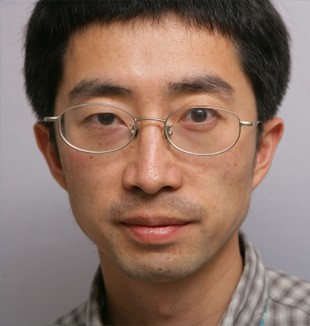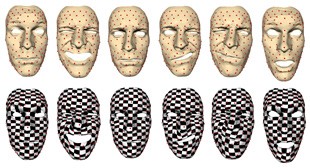By Douglas Gantenbein, Senior Writer, Microsoft News Center
The human face is a complicated thing—powered by 52 muscles; contoured by the nose, eyebrows, and other features; and capable of an almost infinite range of expressions, from joy to anger to sorrow to puzzlement.
Perhaps that is why realistic animation of the human face has been what Microsoft Research Asia scientist Xin Tong calls a “holy grail” of computer graphics. Decades of research in computer graphics have developed a number of techniques for capturing three-dimensional moving images of the human face. But all have flaws, capturing insufficient detail or failing to depict accurately a changing expression.

Microsoft Research Podcast
Collaborators: Holoportation™ communication technology with Spencer Fowers and Kwame Darko
Spencer Fowers and Kwame Darko break down how the technology behind Holoportation and the telecommunication device being built around it brings patients and doctors together when being in the same room isn’t an easy option and discuss the potential impact of the work.
Xin Tong
Now, researchers at Microsoft Research Asia, led by Tong and working with Jinxiang Chai, a Texas A&M University professor, have developed a new approach to creating high-fidelity, 3-D images of the human face, one that depicts not only large-scale features and expressions, but also the subtle wrinkling and movement of human skin. Their work could have implications in areas such as computerized filmmaking and even in creating realistic user avatars for use in conferencing and other applications.
The team’s paper about the facial-scanning research, Leveraging Motion Capture and 3D Scanning for High-fidelity Facial Performance Acquisition, will be presented during SIGGRAPH 2011, being held in Vancouver, British Columbia, Aug. 7-11. SIGGRAPH 2011, the 38th International Conference and Exhibition on Computer Graphics and Interactive Techniques, is expected to attract 25,000 professionals in the fields of research, science, art, gaming, and more.
Microsoft Research scientists contributed to 11 papers that will be presented during SIGGRAPH 2011. In addition, Microsoft researchers will be honored with two major industry awards during the event. Jim Kajiya, a distinguished engineer with Microsoft Research, will receive the Steven Anson Coons Award for Outstanding Creative Contributions to Computer Graphics, and Richard Szeliski, director of Microsoft Research’s Interactive Visual Media Group, will receive the Computer Graphics Achievement Award.
The paper, written by Microsoft Research scientists Tong, Haoda Huang, and Hsiang-Tao Wu, along with Chai, explores a new approach for capturing high-fidelity, realistic facial features and expressions.
That’s a big challenge, Tong says. Not only is the human face remarkably expressive, it’s also a form of communication—we look at people and usually can understand immediately what they are thinking or feeling.
“We are very familiar with facial expressions, but also very sensitive in seeing any type of errors,” he says. “That means we need to capture facial expressions with a high level of detail and also capture very subtle facial details with high temporal resolution,” meaning the subtle motions of those details need to be captured.
Existing means of capturing faces and expressions include marker-based motion capture and high-resolution scanners. In marker-based techniques, small reflective dots are fixed to a face and their relative positions captured on video as the character changes expression. That method results in accurate capture of changing expressions, but with low resolution.
High-resolution scanners, on the other hand, capture all the subtleties in a human face—down to fine wrinkles and skin pores—but typically do so only for static poses. Dedicated setups configured with high-speed cameras, also used for facial capture, are expensive and provide less facial detail.
The team set out to combine both the accurate motion capture of marker systems with the high resolution of scanners. The researchers also wanted to do this efficiently from a computing standpoint, and that required the least amount of data for an accurate facial reconstruction.
Using three actors with highly mobile faces, the researchers first used marker-based motion capture, applying about 100 reflective dots to each actor’s face. With video rolling, the actors made a series of pre-determined facial expressions that enabled the collection of rough data on how faces change with different expressions, for use in 3-D scans.

Top images show how markers create a set of correspondences across all the face scans. The bottom row shows how a two-step face-scan registration produces dense, consistent surface correspondences across all the face scans.
Also, by analyzing the captured marker-based data, the team determined the minimum number of scans required for accurate facial reconstruction.
In the next step, the research team used a laser scanner to capture high-fidelity facial scans. Those scans then were aligned with the corresponding frames in the marker-based facial data. Using a new algorithm, the facial scans were registered with each other.
This was no easy task. The paper notes that geometric details that appear in one scan might not appear in another. Also, even a small mis-alignment of fine-grained features such as wrinkles or pores will make the resulting facial reconstruction appear unnatural.
“We want to make sure these features align, or you will see some weird artifacts,” Tong says. “A wrinkle may appear, then disappear, then appear—it’s not natural.”
To avoid that, the team used a two-step registration algorithm. First, the algorithm registers large facial expressions between the high-definition facial scans. Next, it refines the scans by segmenting the face into discrete areas and aligns each area with the same areas in other scans with the similar appearance to the current scan using optical-flow techniques that take into account the relative motion between a camera and the face.
Lastly, the team combined the motion-capture information with the face scans to reconstruct the actual expressions as they were performed. The resulting images capture both the “big” movements of a face and fine details such as the texture and movement of the skin.
Tong is confident that his team’s work will have an impact in the real world.
“It has a lot of applications,” he says. “That is why we put so much effort into the work.”
For example, the film and video-game industries also could benefit from easier but effective methods for creating virtual faces, leading to virtual characters that are much more lifelike than is common today.
Also, Tong says, the new scanning technique could be used to create computer avatars that could represent a realistic option to the pre-programmed avatars found in devices such as the Xbox 360.
“The character would be virtual, but the expressions real,” he says. “For teleconference applications, that could be very useful, for example, in a business meeting, where people are very sensitive to expressions and use them to know what people are thinking.”
Tong says much work needs to be done, however. Currently his team’s scanning technique does not capture synchronized eye and lip movements. In addition, it takes considerable computing power and several hours to successfully register all of the images. Tong wants that to happen in real time.
“There are a lot of challenges,” he concludes, “but it is a very exciting research area.”
Microsoft Research Contributions to SIGGRAPH 2011
Antialiasing Recovery
Lei Yang, The Hong Kong University of Science and Technology; Pedro Sander, The Hong Kong University of Science and Technology; Jason Lawrence, University of Virginia; and Hugues Hoppe, Microsoft Research Redmond.
Depixelizing Pixel Art
Johannes Kopf, Microsoft Research Redmond; and Dani Lischinski, The Hebrew University of Jerusalem.
Differential Domain Analysis for Non-Uniform Sampling
Li-Yi Wei, Microsoft Research Redmond; and Rui Wang, University of Massachusetts Amherst.
Discrete Element Texture Synthesis
Chongyang Ma, Microsoft Research Asia; Li-Yi Wei, Microsoft Research Redmond; and Xin Tong, Microsoft Research Asia.
Example-Based Image Color and Tone Style Enhancement
Baoyuan Wang, Zhejiang University; Yizhou Yu, University of Illinois at Urbana-Champaign and Zhejiang University; and Ying-Qing Xu, Microsoft Research Asia.
Geodesic Image and Video Editing
Antonio Criminisi, Microsoft Research Cambridge; Toby Sharp, Microsoft Research Cambridge; Carsten Rother, Microsoft Research Cambridge; and Patrick Pérez, Technicolor Research and Innovation.
Leveraging Motion Capture and 3D Scanning for High-fidelity Facial Performance Acquisition
Haoda Huang, Microsoft Research Asia; Jinxiang Chai, Texas A&M University; Xin Tong, Microsoft Research Asia; and Hsiang-Tao Wu, Microsoft Research Asia.
Matting and Compositing of Transparent and Refractive Objects
Sai-Kit Yeung, University of California, Los Angeles; Chi-Keung Tang, The Hong Kong University of Science and Technology; Michael S. Brown, National University of Singapore; and Sing Bing Kang, Microsoft Research Redmond.
Nonlinear Revision Control for Images
Hsiang-Ting Chen, National Tsing Hua University; Li-Yi Wei, Microsoft Research Redmond; and Chun-Fa Chang, National Taiwan Normal University.
Pocket Reflectometry
Peiran Ren, Tsinghua University; Jiaping Wang. Microsoft Research Asia; John Snyder, Microsoft Research Redmond; Xin Tong, Microsoft Research Asia; and Baining Guo, Microsoft Research Asia.
ShadowDraw: Real-Time User Guidance for Freehand Drawing
Yong Jae Lee, University of Texas at Austin; C. Lawrence Zitnick, Microsoft Research Redmond; and Michael F. Cohen, Microsoft Research Redmond.




